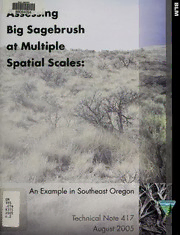Table Of ContentBLM LIBRARY
ng
Sagebrush
Big
at Multiple
Spatial Scales:
4/
£*.
/
Ifgrpai Js>-ll
10*
An Example Southeast Oregon
in
WM
QK
495
.C74
K375
2005
c.2 Technical Note 417
2005
August
Production services provided by:
BLM National Science and Technology Center
Branch of Publishing Services
Copies available from:
BLM National Business Center
Printed Materials Distribution Service, BC-652
P.O. Box 25047
Denver, Colorado 80225-0047
Fax: 303-236-0845
E-mail: [email protected]
TN417
BLM/ST/ST-05/001+4400
m
-<
&
&&0WD4H ftK.
Assessing
Big Sagebrush
iX
at Multiple
Spatial Scales:
An Example in Southeast Oregon \
Technical Note 417
August 2005
&*
By Mike "Sherm" Karl
A*
Inventory and Monitoring Specialist
#
Bureau of Land Management #
#
National Science and Technology Center c«S>
#£&t+
A>*
Denver, Colorado
Jon Sadowski
Wildlife Biologist
Bureau of Land Management
Vale District
Jordan Resource Area
Vale, Oregon
August 2005
Suggested citation:
Karl, M. and J. Sadowski. 2005. Assessing big sagebrush at multiple spatial scales: An example in
southeast Oregon. Technical Note 417. BLM/ST/ST-05/001+4400. Bureau of Land Management,
Denver, CO. 41 pp.
Acknowledgments
The synthesis of thought presented in this exam- Oregon Department of Fish and Wildlife
ple has been influenced greatly by the concepts WaltVan Dyke
of wildlife habitat management promoted in Jim Lemos (retired)
Oregon by Jack Ward Thomas, Chris Maser, and Jerry Farstvedt (retired)
Ralph Anderson. Their practical ideas about Bill Olson (retired)
wildlife habitat in managed forests and range- Jack Melland (retired)
lands were adapted for this management archi-
tecture and they are respectfully acknowledged. The Nature Conservancy t:
Alan Sands
Thanks to the following BLM coworkers and indi-
viduals outside BLM who were consulted in the U.S. Forest Service
formulation of this management strategy for the Mary Rowland
Southeast Oregon Resource Management Plan or Mike Wisdom
who provided review comments or photos that
improved the content of this document: U.S. Fish and Wildlife Service
Rich Howard
Bureau of Land Management
Fred Taylor (now with Bureau of IndianAffairs) U.S. Geological Survey
Jan Hanf Steve Knick
Todd Thompson
Al Bammann (retired) Agricultural Research Service
JerryTaylor Jon Bates (supplied photos)
Jim May (retired)
Geoff Middaugh Izaak Walton League
George Buckner Monty Montgomery
Doug Powell
JackWenderoth Grouse, Inc.
Cynthia Tait Clait Braun
Marisa Meyer (nowwith U.S. Fish andWildlife Service)
Steve Christensen Idaho Department of Fish and Game
Tom Forre Jack Connelly
Tom Miles
Jean Findley Oregon State University
Richard Mayberry John Crawford
Bob Kindschy (retired) Richard Miller
Signe Sather-Blair
Terry Rich (nowwith U.S. Fish andWildlife Service)
Mike Pellant m
Allan Thomas (retired)
Judy Nelson (retired)
Erick Campbell (retired)
Susan Giannettino
Craig MacKinnon
-:
-
Table of Contents
Acknowledgments
i
Abstract 1
Introduction 3
Assessment Process 5
Define Assessment Scales 5
Create Canopy Cover Classes 5
Class 1 : No Sagebrush Canopy Cover (Grassland) 6
Class 2: Trace to 5 Percent Sagebrush Canopy Cover (Grassland) 8
Class 3: Greater than 5 Percent to 15 Percent Sagebrush Canopy Cover (Shrubland) 8
Class 4: Greater than 1 5 Percent to 25 Percent Sagebrush Canopy Cover (Shrubland) 9
Class 5: Greater than 25 Percent Sagebrush Canopy Cover (Shrubland) 10
Make Mid-Scale Assessments 10
Place Mid-Scale Conditions in the Context of Broad-Scale Findings 10
Determine Mid-Scale Objectives 15
Identify Mid-Scale Geographic ManagementAreas 15
Determine Mid-Scale Geographic ManagementArea Objectives 17
Make Fine-Scale Determinations 18
Determine Fine-Scale, Pasture-Level Objectives 18
Evaluate Achievement of Oregon's Rangeland Health Standard 5 18
Determine Site (Local, Within Pasture) Subclasses 24
Subclasses for Class 1 24
Subclasses for Class 2 26
Subclasses for Class 3 29
Subclasses for Class 4 30
Subclasses for Class 5 31
Summary ofAssessment Steps and Results 35
References Cited 39
\
Abstract
This technical note describes how big sagebrush pasture) levels. The scales are interrelated and
habitats {Artemisia tridentata, including played equally important roles in building man-
Wyoming, basin, and mountain subspecies) are agement objectives. Big sagebrush canopy cover
being assessed and managed at multiple spatial structural classes were created, which were the
.-Jff-A
scales within a Bureau of Land Management basic building blocks of the sagebrush objectives
resource area in southeast Oregon. It shows how and which addressed spatial patterning of habi-
the assessment results can be used to make tat structure, connectivity, and fragmentation, as
determinations pertaining to standards and well as the cumulative effects of disturbance
guidelines for greater sage-grouse and other from fires and land treatments. Findings from
animals that use sagebrush habitats. In this the Interior Columbia Basin Ecosystem
example, the assessment included information at Management Project and more local information
the broad-scale (Interior Columbia Basin from the Jordan Resource Area of BLM's Vale
Ecosystem Management Project; 145 million District were used to guide development of
acres), mid-scale (Southeast Oregon Resource mid-scale big sagebrush habitat objectives. This
Management Plan-Final Environmental Impact example provides other BLM field offices in the
Statement; 4.6 million acres, and Louse Canyon sagebrush biome with ideas for how they might
Geographic ManagementArea; 0.52 million develop their own multiple-scale big sagebrush
acres), fine-scale (pasture; less than 2,000 to assessment to achieve land use plan objectives
88,000 acres), and site- or local-scale (ecological and rangeland health standards.
site; variable in size but typically smaller than

